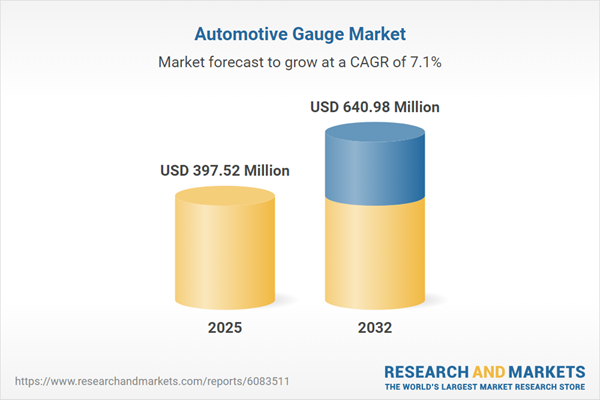Speak directly to the analyst to clarify any post sales queries you may have.
The automotive gauge market is rapidly adapting to technological innovation, evolving safety requirements, and changing regional demand. Senior industry leaders must steer through ongoing shifts in vehicle instrumentation and connectivity, ensuring operational resilience and market relevancy.
Market Snapshot: Automotive Gauge Market Overview
The global automotive gauge market is witnessing steady expansion, reflected in its progression from USD 371.23 million in 2024 to USD 397.52 million in 2025, with expectations to reach USD 640.98 million by 2032 at a CAGR of 7.06%. This growth is propelled by increasing demand for modern vehicle displays, swift integration of connected car technologies, and more sophisticated sensor solutions. Digital clusters are replacing analog panels as manufacturers address stricter compliance demands and prioritize user-friendly, performance-driven instrumentation. The market dynamic is further shaped by shifts in both hardware and software, compelling companies to proactively respond to regulation and evolving buyer preferences.
Scope & Segmentation of the Automotive Gauge Market
This report delivers comprehensive analysis of the automotive gauge market, providing guidance on differentiation, distribution, and regional opportunities. The scope covers the following key segments relevant for strategic planning and operational optimization:
- Gauge Types: Includes both analog and digital gauges, with display formats ranging from LCD to LED. These technologies offer flexibility in data presentation, enabling manufacturers to tailor functionality for diverse vehicle specifications.
- Vehicle Types: Covers commercial vehicles such as heavy and light-duty models, alongside passenger cars like hatchbacks, sedans, coupes, and SUVs. Each category brings distinctive needs for instrument durability, user experience, and interface sophistication.
- Sales Channels: Considers direct and online aftermarket solutions supporting fleet upgrades as well as original equipment manufacturer (OEM) channels focused on integration during new vehicle assembly.
- Regions Covered: Provides detailed insights across the Americas (including the US, Canada, Mexico, Brazil, Argentina, Chile), Europe, Middle East & Africa (encompassing the United Kingdom, Germany, France, Russia, UAE, South Africa), and Asia-Pacific (featuring China, India, Japan, South Korea, Australia, Indonesia, and other Southeast Asian markets). Each region highlights different growth drivers and regulatory backdrops.
- Key Companies Analyzed: Profiles leading entities such as Continental AG, Visteon Corporation, Robert Bosch GmbH, Denso Corporation, Marelli Holdings Co. Ltd., Hella KGaA Hueck & Co., and Yazaki Corporation, whose strategies influence market direction and adoption rates for emerging technologies.
Key Takeaways for Decision-Makers
- Digitalization is advancing gauge design, allowing user-configurable interfaces and supporting proactive driver information and safety functions.
- Deeper integration with telematics and advanced driver-assistance systems enables seamless connectivity and equips vehicles for predictive diagnostics and system monitoring.
- Segmentation by vehicle and distribution method reveals diverse buyer priorities: commercial operators often focus on serviceability and robustness, while passenger vehicle buyers seek advanced displays and enhanced interactivity.
- Regional variations demand tailored go-to-market approaches; North American and European demand prioritizes innovative digital instrumentation, whereas Asia-Pacific’s manufacturing capabilities support large-scale adoption of cost-effective gauge solutions.
- Optimized supply chains—leveraging partnerships, local manufacturing, and vertical integration—help mitigate risks and adapt to evolving regulatory requirements.
- Cross-sector collaboration among sensor and display manufacturers, along with OEMs, is essential for delivering market-specific solutions that align with changing operational and legislative needs.
Impact of 2025 US Tariffs on Supply Chain and Cost Structures
The introduction of new US tariffs on imported automotive components is reshaping cost structures across the automotive gauge industry. Increased material and electronics costs lengthen procurement cycles and increase sourcing complexity, prompting industry players to adjust operational strategies. Common responses include ramping up investments in automation, exploring alternative sourcing options, and enhancing domestic production capabilities to maintain supply chain continuity and regulatory compliance.
Methodology & Data Sources
The research applies robust methodologies, combining extensive reviews of industry, regulatory, and academic literature with direct interviews of OEMs, suppliers, and distributors. Trend analysis uses advanced segmentation validated through peer review and data triangulation for accuracy and relevancy.
Why This Report Matters
- Gain actionable guidance to address the ongoing challenges of technology adoption, compliance management, and regional market entry in the automotive gauge sector.
- Leverage robust segmentation and regional analysis to guide investment and product portfolio decisions.
- Identify opportunities to partner with established and emerging leaders shaping global vehicle instrumentation innovation.
Conclusion
Adapting to ongoing changes in technology, regulations, and buyer expectations is crucial for long-term success in the automotive gauge market. Forward-thinking leaders who prioritize innovation and operational flexibility will reinforce their market position as the industry evolves.
Table of Contents
3. Executive Summary
4. Market Overview
7. Cumulative Impact of Artificial Intelligence 2025
Companies Mentioned
The companies profiled in this Automotive Gauge market report include:- Continental AG
- Visteon Corporation
- Robert Bosch GmbH
- Denso Corporation
- Marelli Holdings Co. Ltd.
- Hella KGaA Hueck & Co.
- Yazaki Corporation
Table Information
| Report Attribute | Details |
|---|---|
| No. of Pages | 195 |
| Published | November 2025 |
| Forecast Period | 2025 - 2032 |
| Estimated Market Value ( USD | $ 397.52 Million |
| Forecasted Market Value ( USD | $ 640.98 Million |
| Compound Annual Growth Rate | 7.0% |
| Regions Covered | Global |
| No. of Companies Mentioned | 8 |









